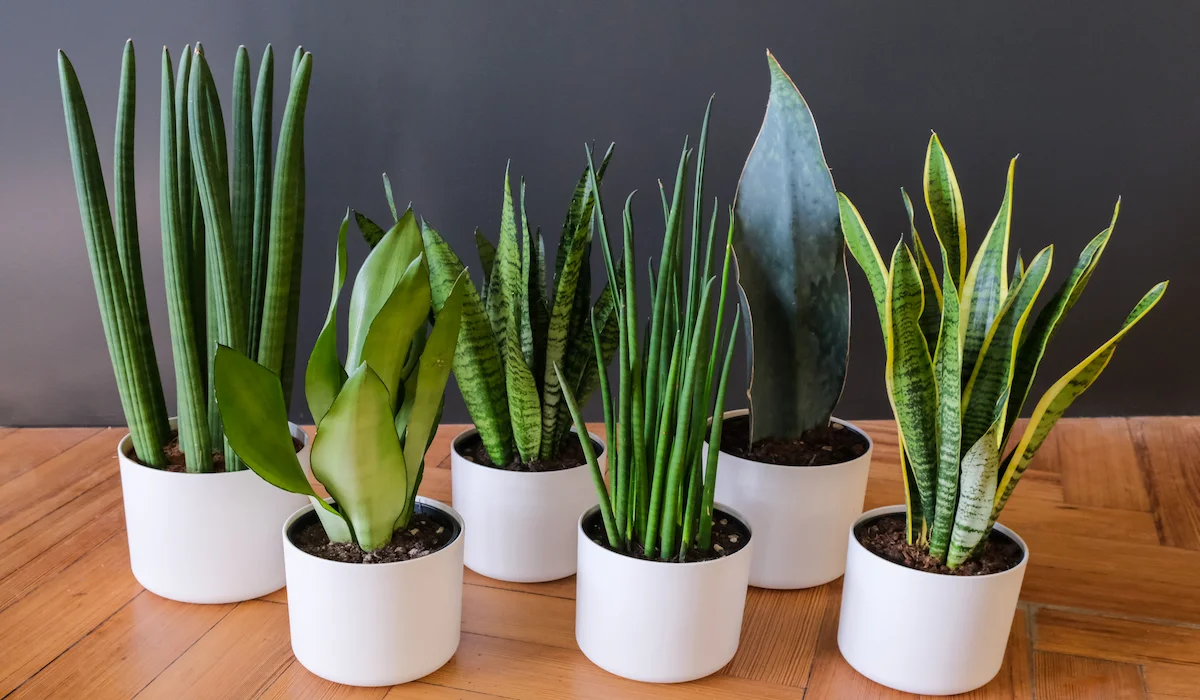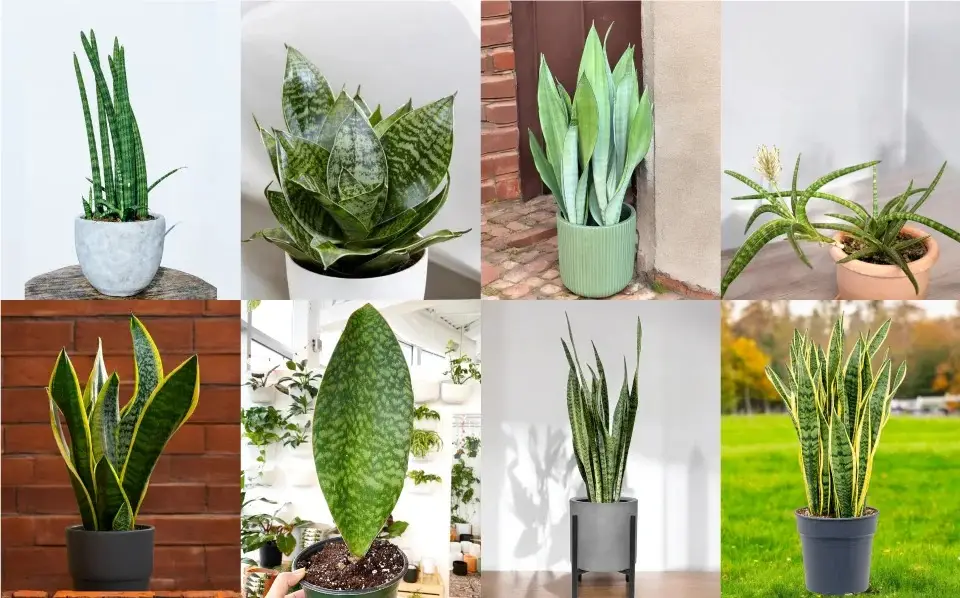The snake plant (Sansevieria), also known as Mother-in-law’s Tongue, is one of the most popular houseplants worldwide. As a member of the Asparagus family, it is loved for its low maintenance, air-purifying abilities, and sleek aesthetic that fits perfectly into any home or office space. With its distinctive sword-like leaves that grow upright, the plant adds a modern and striking look to any indoor setting.
They’re forgiving, adaptable, and require minimal care, making them perfect for busy lifestyles or those new to indoor gardening. Beyond their practical benefits, snake plants are also associated with spiritual significance, making them a favored choice in homes that follow Feng Shui principles.
Plus, they’re packed with benefits, from improving air quality to boosting your mood, making them an ideal companion for any living space.

Also Known As | Sansevieria, Mother-in-law’s tongue, Viper’s bowstring hemp, Saint George’s sword |
Scientific Name | Dracaena Trifasciata |
Family | |
Plant Type | A long-lasting plant that stays green year-round and is commonly kept indoors |
Leaves | Sword-shaped, upright, and evergreen |
Mature Size | 2.3–3.0 ft (70–90 cm) long and 2.0–2.4 inches (5–6 cm) wide |
Best Soil Type | Sandy, loamy, or succulent soils |
Flowering Season | Spring |
Flower Color | White |
Place of Origin | West Africa |
Hardiness Zones | 10 to 12 |
Toxicity | Toxic to cats and dogs |
Snake plants are primarily native to West Africa, particularly in countries like Nigeria, the Democratic Republic of the Congo, and Ghana. They grow naturally in dry, rocky soils and are well-adapted to harsh climates with minimal water availability. Their ability to store moisture in their thick, sword-like leaves allows them to survive prolonged droughts, making them one of the most resilient houseplants.
Over time, different varieties of snake plants have been discovered across southern Asia and Madagascar, further expanding their natural range. These regions provided the perfect conditions for the plant to flourish in both arid and tropical environments.
The snake plant’s journey from its African roots to becoming a global houseplant icon can be attributed to its durability, air-purifying qualities, and cultural significance.

Many stunning snake plant varieties come in a variety of shapes, sizes, and patterns, making them a versatile choice for any indoor space. While they all share the same hardy nature and air-purifying benefits, different varieties bring unique aesthetics to the table.
Some of the most well-known types include:
Snake plants are not only admired for their sleek, modern look but also for the numerous benefits they bring to indoor spaces. Whether you’re a seasoned plant lover or just getting started, this hardy plant offers more than just aesthetics.
Here are just a few of the snake plant benefits you can enjoy:
One of the reasons snake plants are so popular is their effortless care routine. Whether you’re a beginner or a seasoned plant owner, this resilient plant thrives with minimal attention.
Here are some basic care tips to keep your snake plant healthy:
So, these are the essential things you need to know about the snake plant.
With its minimal care requirements and numerous benefits, it’s no wonder the snake plant has become a beloved choice for plant lovers worldwide. Whether you’re looking to enhance your home décor, improve air quality, or simply enjoy a low-maintenance companion, the snake plant has got you covered.
There you have it—armed with these care tips and insights, you’re ready to welcome a snake plant into your space and watch it thrive with ease.
Yes, it is good to sleep next to a snake plant. Snake plants are known for their ability to purify the air by removing toxins like formaldehyde, benzene, and xylene. They also release oxygen at night, unlike most plants that release oxygen during the day. This unique trait makes them an excellent choice for bedrooms, as they can improve air quality and promote better sleep.
No, the snake plant is not toxic to touch. However, it contains saponins, which can be mildly toxic if ingested. Touching the plant is generally safe, but it’s a good idea to wash your hands afterward, especially if you have sensitive skin. Keep the plant away from pets and children who might chew on the leaves.
Snake plants are drought-tolerant and prefer to be underwatered rather than overwatered. Water your snake plant every 2-6 weeks, depending on the season and environment. In winter, reduce watering to once a month or less. Always allow the soil to dry out completely between waterings to prevent root rot.
Yes, it is perfectly fine to have a snake plant in the bedroom. As mentioned earlier, snake plants release oxygen at night and improve air quality, making them ideal for bedrooms. They are also low-maintenance and thrive in low-light conditions, which are common in bedrooms.
The best place for a snake plant is somewhere with indirect sunlight, such as near a window with filtered light. They can also tolerate low-light conditions, making them suitable for offices, bathrooms, or darker corners of your home. Avoid placing them in direct sunlight for extended periods, as this can scorch the leaves.
Yes, snake plants release oxygen during the day through the process of photosynthesis. However, their unique ability to perform Crassulacean Acid Metabolism (CAM) allows them to also release oxygen at night, making them one of the few plants that improve air quality around the clock.
You can put your snake plant outside during warmer months, but it should be placed in a shaded or semi-shaded area to avoid direct sunlight, which can damage the leaves. Bring it indoors before temperatures drop below 50°F (10°C), as snake plants are not frost-tolerant.
No, snake plants do not need to be by a window. They are highly adaptable and can thrive in low-light conditions. However, they will grow faster and healthier if placed near a window with indirect sunlight. If your home has limited natural light, a snake plant is still a great choice.
Snake plants are generally resistant to pests, but they can occasionally attract spider mites, mealybugs, or fungus gnats, especially if overwatered. To prevent bugs, avoid overwatering, keep the leaves clean, and inspect the plant regularly. If pests appear, treat them with insecticidal soap or neem oil.
Snake plant leaves may fall over due to:
To fix this, reduce watering, ensure proper drainage, and move the plant to a brighter location if necessary.
If your snake plant is dying, follow these steps to revive it:
With proper care, your snake plant should recover and thrive.